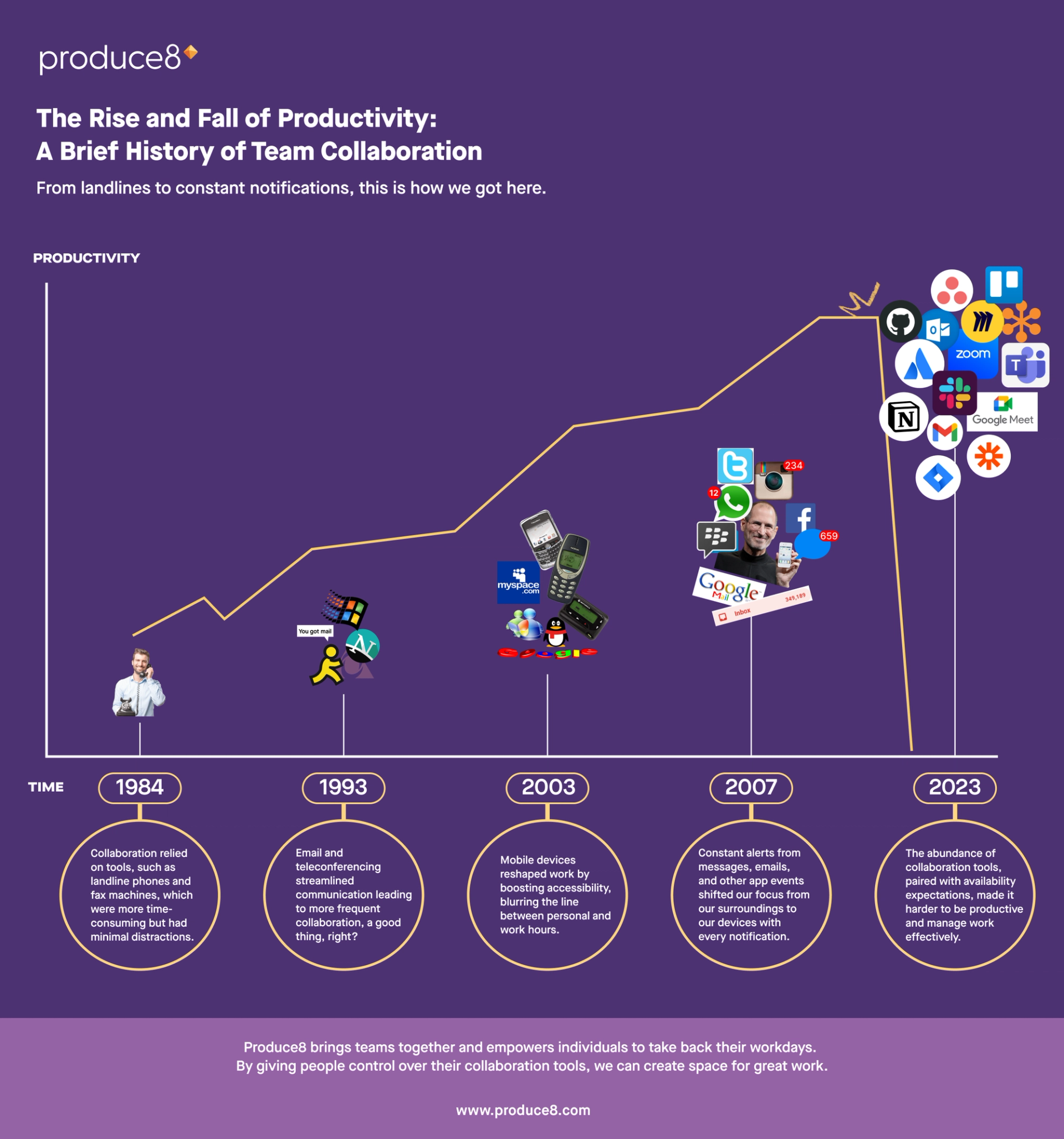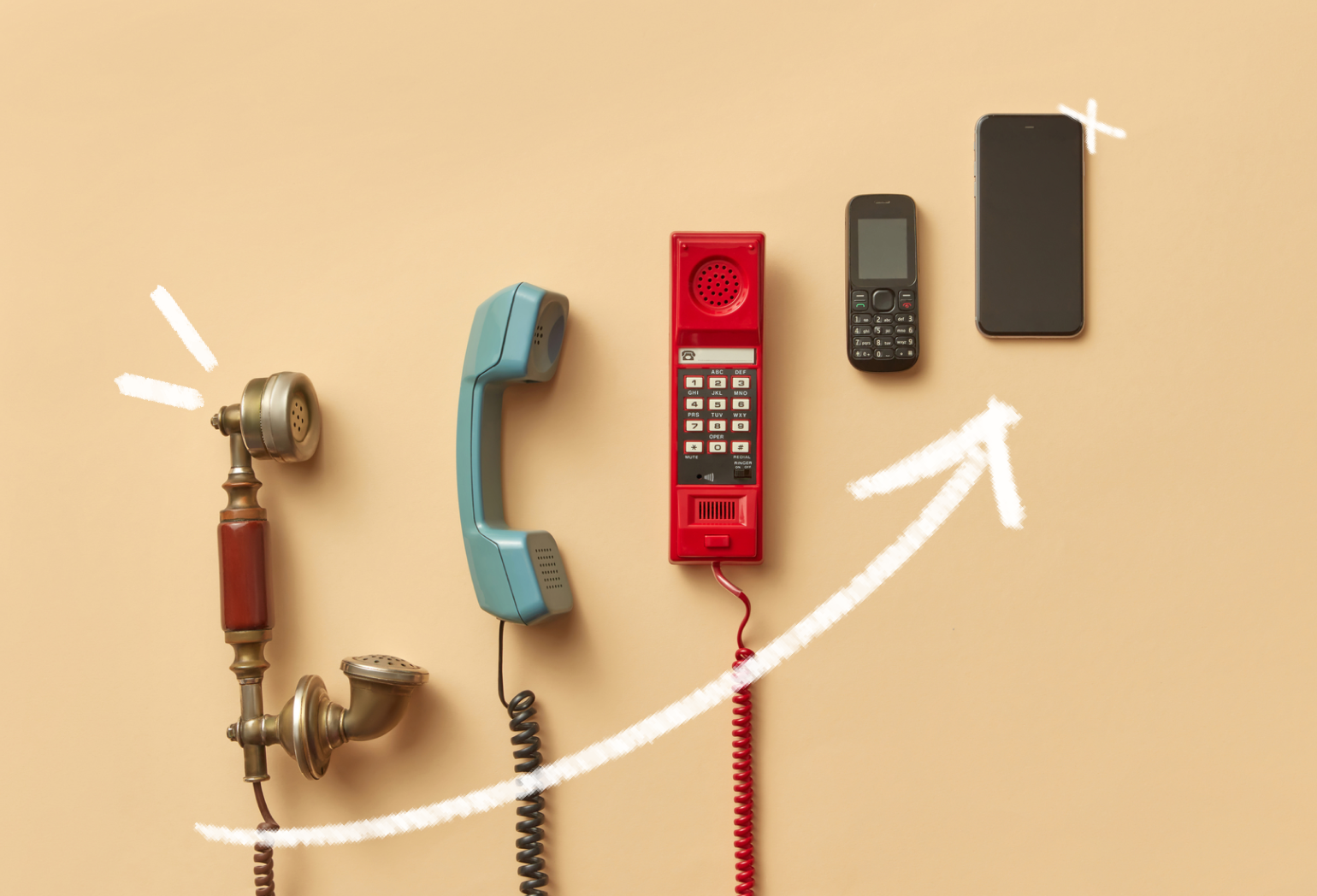Produce8
MSPs looking for the Produce8 Playbook, look no further!
The History of Digital Collaboration: The Rise and Fall of Productivity
Meetings and messages are the foundation of work collaboration. But they're taking up too much of our productivity time.
The fact is that collaboration is affecting our ability to focus on important tasks. Our productivity is declining, even with all the apps we use. The rise of tools like Zoom and Slack has made communication easy, but we have less time for deep work. Here are a few troubling statistics:
- One in four workers thinks that an excessive number of meetings causes missed deadlines .
- Today, the typical knowledge worker gets notifications from six different applications.
- 90% of workers dedicate up to five hours daily to checking work messenger apps such as Slack or Microsoft Teams.
It’s clear we're on a downward trend. But before we talk about fixing the problem, let's figure out how we got here.

(1983-1993) The landline era
In the early 1980s, collaboration depended on landline phones, fax machines, and in-person meetings, making tasks more time-consuming. Collaborative efforts required physical presence, followed a structured approach, and were scheduled for specific purposes like project updates, decision-making, or problem-solving.
But while meetings were common in ‘80s office life, they were typically shorter and less frequent compared to the current work environment.
Meetings have been getting longer over the past 50 years. In 2017, executives spent about 23 hours per week in meetings. That’s a huge jump from the less than 10 hours they’d spend in meetings in the ‘60s. Meetings have even grown about 10% longer since 2000 .
As we address today's collaboration challenges, we must acknowledge the progress we've made. We've come a long way from relying solely on memos and face-to-face meetings. But distractions were also far less pervasive during that era. A colleague had to physically enter your workspace and tap you on the shoulder to get your attention.
As the ‘80s rolled into the ‘90s, personal computers became more affordable and increasingly powerful. Businesses embraced these machines, recognizing their potential to enhance productivity.
(1994-2004) The email and teleconferencing era
In the mid-1990s, the internet became a fixture in offices. Email rose as the primary mode of communication, overtaking traditional mail and fax machines.
Email enabled near-instant communication (in contrast to the days or weeks needed for traditional mail and fax). However, its popularity quickly led to email overload, with people returning from vacations to hundreds of unread messages. This is a challenge we all still face today, with the average person receiving over 100 emails per day.
Furthermore, the 1990s saw the rise of teleconferencing technologies, which transformed long-distance collaboration. These technologies reduced the need for in-person meetings and altered the dynamics of meeting times.
The convenience of teleconferencing increased the frequency of meetings. Since participants didn't need to travel, it became easier to schedule and attend meetings, resulting in more regular communication.
The ease of meetings ultimately led to more opportunities to take employees away from their work. Today, workers view 71% of meetings as unproductive and inefficient.
The ‘90s marked a significant technological transformation. People were beginning to grasp the potential of the internet and email, which had boosted productivity. The future seemed promising.
But as we adapted to these changes, another major workplace innovation loomed on the horizon.
(2004-2012) The handheld devices and notification era
The arrival of mobile devices revolutionized how professionals engage in meetings and messages. These devices enhanced connectivity, accessibility, and collaboration.
In the early 2000s, as mobile devices became more prevalent, the amount of time spent in meetings further increased. Knowledge workers often had packed schedules, and collaboration varied in length from quick check-ins to full-day sessions, blurring the line between personal and work lives.
In 2021, 34% of employees admitted they struggled to avoid checking work notifications at home , while 29% faced a similar challenge with personal notifications at work.
With the rise of smartphones, work was no longer confined to a specific place. Instead, it followed us everywhere, always vying for our attention. We received constant alerts for messages, emails, and events, regardless of their importance. Our focus shifted from our surroundings to our devices with every notification.
And yet in the 2000s, we welcomed these changes in how we work, even though they introduced distractions.
(2012-2020) The instant messaging era
Launched in 2013, Slack quickly became popular as a work-focused messaging app. Microsoft Teams, another work collaboration tool, followed in 2017.
These apps replaced long email threads and made communication more immediate. According to Slack , using the app reduces emails by 32% and meetings by 27%.
However, messaging apps have also led to excessive communication. As of 2020, the average knowledge worker spends more than 90 minutes in Slack every workday.
The instant nature of apps like Slack and Microsoft Teams meant quick responses were expected, thus disrupting focused work. Remote work and virtual collaboration gained traction, allowing team members to connect from anywhere. This led to more spontaneous, lengthy meetings.
While the workplace was on the brink of a significant shift in how people collaborate, nobody expected the technological acceleration that was about to occur.
(2020-2023) Zoom meetings and remote work era
In early 2020, government-imposed lockdowns pushed people to work remotely and made video call tools like Zoom, Microsoft Teams, and Google Meet vital for collaboration. Virtual meetings became more frequent and longer, and a focus on regular check-ins and team-building activities was emphasized.
But the heavy use of platforms like Zoom raised productivity challenges, including information overload and burnout. Excessive, often back-to-back video calls resulted in video call fatigue, impacting mental well-being.
A 2022 survey revealed that 37.1% of employees found Zoom fatigue was the greatest challenge of virtual meetings.
With greater expectations to be active and available — while also being productive — high performers, feeling unrecognized and isolated, experienced a general decline in their well-being .
And this is where we currently find ourselves.
We now understand that while collaboration is essential to our work, it’s not without its detrimental effects. And we’ve learned that something has been missing all along — a tool to unite the entire team. We have witnessed collaboration tools aid us in making communication frictionless. Now, we require a collaboration tool that helps us understand one another and our work habits so we can actually focus on what matters.
What will the next collaboration era look like?
We stand at the precipice of a productivity cliff.
Workers today face numerous interruptions from tools like Slack and Zoom, which was not the case a decade ago. Many organizations and leaders are making quick decisions regarding office work and meetings, but it's often a guessing game with no winners. To solve this problem, we should actually put the problem on the table — not the people.
Previously, the responsibility for productivity and well-being was placed solely on individuals. Overcoming distractions was seen as a characteristic of high performers. However, we now realize that leaving workers to navigate a flawed work environment alone leads to burnout . Sweeping changes by organizations often don't consider the individual impact, and workers are left to adapt on their own.
Fixing collaboration is a team — and often systemic — issue, not something individuals can solve by setting boundaries or taking breaks. Organizations must shift their mindset and create an environment that supports deep work, minimizes distractions, and nurtures well-being.
Understanding how different workers operate is key. One solution doesn't fit all. We need data to visualize the workday, attack the collaboration problem, and stop blaming individuals.
At Produce8 , we bring teams together and empower individuals to take back their workdays. By giving people control over their collaboration tools, we can create space for great work.
Related Aritcles
Digital Work Analytics reporting
AIRO Part 4 - From Reactive IT to Managed AI - The Next Evolution for MSPs
2 min read
Unlock great workdays
Wether you are collaborating with your team or solo tackling your day we can help you recover the most valuable asset, time.
